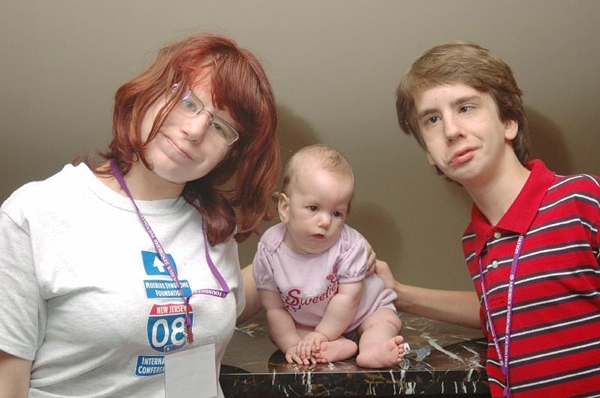Moebius Sequence
MOEBIUS SYNDROME /SEQUENCE
Moebius Sequence is a rare and complex congenital anomaly affecting multiple cranial nerves. A recent Dutch survey estimates the incidence of Moebius Sequence to be 0.002% of all live births whereas Zuker et al estimate it to be lower, 0.0005%.
Prof George Psaras reports as follows: “In 1880 von Graefe et al. first described bilateral facial paralysis. It was not until 1888 when a neurologist from Leipzig by the name Paul Julius Moebius classified various congenital cranial nerve palsies and singled out combined VI and VII nerve paralyses. This condition came to be known as Moebius syndrome (1). At the time the syndrome was mainly characterized by the clinical features of facial and abducens paralysis and was most often diagnosed by ophthalmologists.
Recently the name was changed to Moebius Sequence since it is believed that a primary aetiological insult during pregnancy is followed by a cascade of secondary events that lead to the final clinical picture”

One of the most frustrating aspects of coping with Moebius Sequence is the surprising lack of awareness among physicians and nurses. It occurs so infrequently that many children go undiagnosed for months and sometimes years after birth. Parents and those affected spend a lot of time and emotional energy explaining and re-explaining this rare condition.
The rarity of Moebius Sequence becomes, in effect, an additional complication of the disorder. Because so few members of the professional and the public have heard of Moebius Sequence, medical and social support, are severely limited.
Although they may crawl and walk later, most children with Moebius Sequence eventually catch up. Speech problems are improved through therapy, but may persist due to impaired mobility of the tongue and/or mouth. As children get older, the lack of facial expression and an inability to smile may become the dominant visible symptoms. Moebius Sequence is sometimes but usually infrequently, accompanied by Pierre Robin Syndrome, Poland's Syndrome, Autism etc.
The unfortunate is that unless they undergo a special operation, children with Moebius Sequence will never be able to smile.
SYMPTONS MAY INCLUDE:
- Lack of facial expression; inability to smile
- Feeding, swallowing and choking problems
- Keeping head back to swallow
- Eye sensitivity due to inability to squint
- Motor delays due to upper body weakness
- Absence of lateral eye movement
- Absence of blinking
- Strabismus (crossed eyes)
- Drooling
- High palate
- Short or deformed tongue
- Limited movement of tongue
- Submucous cleft palate
- Dental problems
- Hearing impairment
- Articulation / speech disorders
- Minor mid-line anomalies
- Club feet
- Hand/feet deformities
Understandably, many parents go through stages of utter shock, denial, and often find themselves overwhelmed with anxiety. Despite this, it is of vital importance to remain focused and to recognize the child’s potential. Given the latest medical interventions and different therapies, there is absolutely no reason at all for any child who have been diagnosed with MS to be able to lead a productive and satisfying life. Many adults with Moebius Sequence across the world have succeeded leading fulfilling lives, achieved academically, have friends and fully participate in social and physical activities.
“In addition to the physical findings mentioned above the treating physician has to pay special attention to the severe anxiety experienced by parents when they come to the realization that their newborn baby is suffering from facial paralysis. Multiple counselling sessions and a thorough explanation of the problem including possible treatment options must be undertaken as soon as a diagnosis is established.
Very often, if the paralysis happens to be partial or incomplete the attending paediatrician does not establish a diagnosis in the early days of life. The patient and his/her parents may present to the paediatrician at a later stage in life questioning the presence of facial asymmetry when the baby cries.
The incidence of congenital facial paralysis is estimated to be 1.8% of live births. The vast majority of these (78-90%) are associated with birth trauma. It is speculated that forceps delivery is associated with a large number of traumatic facial paralyses. Most of these recover spontaneously.”(reported by Prof G Psaras)
The Moebius Syndrome Foundation – Africa (hereafter referred to as MSFA) initiative is an attempt to provide non-financial support to children born with Moebius Syndrome and their parents. The support hinges around information-sharing, such as coping skills for feeding, which often is the most concerning factor at birth. Furthermore, the need to document and trace children with Moebius Syndrome will form an integral part.
The idea to form MSFA was formulated in May 2007 after a ‘Smile Operation’ was performed on a teenager who was diagnosed with the Syndrome. The operation was sponsored by the Smile Foundation. The teenager, Wesley von Willingh was the initiator of the project. He encouraged his mother, Kay, to offer her support to parents who have children with Moebius Syndrome, after watching her do this during his stay in hospital.
Contact was made with the international Moebius Support Group in the United States of America who encouraged Kay to start the organisation in South Africa. After the untimely death of Wesley in July 2007, this became a pressing desire for Kay to honour his last wish.
The Smile Foundation, initiated by former President Nelson Mandela after having read a letter from a mother of a child who has Moebius Sequence, have hosted close on to 20 Smile Weeks thus far. Prof George Psaras heads up the team of dedicated skillful and caring doctors who operate on children with facial anomalies like cleft-lip, cleft-lip and palate, facial burns and Moebius Sequence.
Contact can me made with MSFA on kay@moebiussyndromeco.za or Moira Gerszt on moira@smilefoundationsa.org or Prof George Psaras on georgep@moebiussyndrome.co.za
“OUR SMILES COME FROM OUR HEARTS”
http://www.moebiussyndrome.co.za



